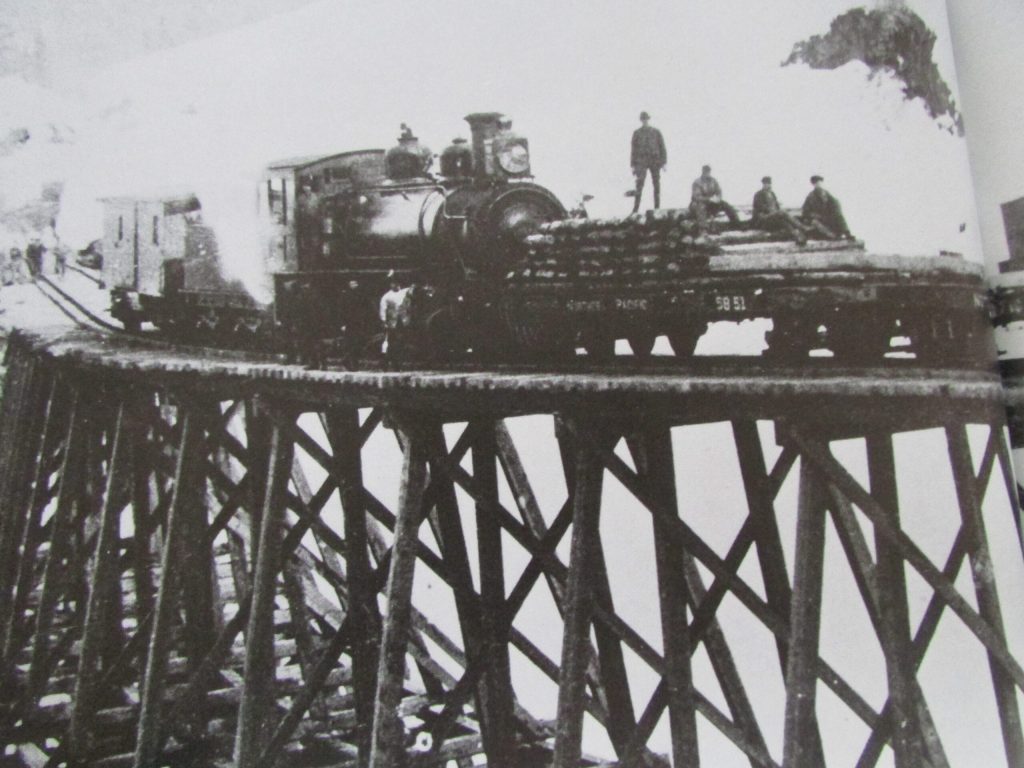Train of Doom – Fiery Wreck of No. 7 at McDonough, Georgia
Published 1:37 pm Sunday, June 2, 2024
|
Getting your Trinity Audio player ready...
|
Some ghosts seem to become the subjects of many legends. They are usually the ones that have met with an unspeakable end. In the true story that we will talk about today, there were multiple deaths, which have caused a deep, dark energy to haunt the town of McDonough, Georgia. There is one other player in our story and that is a train that has been trying to reach its destination for over a century, old No. 7. The story and the hauntings have been investigated by residents as well as ghost hunters since the accident happened.
Throughout the stillness of the gorge, many people say that the train can still can be heard, trying to crossover the broken bridge. Each time, it falls and causes the death of everyone on board, except for nine passengers. So horrific is this accident, that it has been given the name: the “Titanic of Georgia.”
I hope that you are interested in this true story. I have brought a fresh peach pie and a pot of hot coffee for us to enjoy as we learn about this tragic happening.
It was June 23, 1900. The weather was awful that night, when the No. 7 train left Macon at 7:10 pm. Nevertheless, it was still expected to be in Atlanta at 9:55 pm. It was the main passenger train, which ran on the Macon branch of the Southern Railway’s route to Atlanta. It reached the station in McDonough on time, 8:50 pm. Here, it stopped to pick up passengers, despite the amount of rain that had produced a flash flood of epic proportion and caused Camp Creek to overflow its banks.
A train from Columbus was due to connect with No. 7 at McDonough. However, it was late. As No. 7 sat on the tracks at the depot, a Pullman sleeper car was attached. Now the train consisted of the engine, baggage car, several second-class coaches and the Pullman.
The train that was coming from Columbus never arrived but the Red Ball freight train carrying two people did come through and was waived on by the flagman. A little later, it crossed over the Camp Creek Bridge, making it the last train to do so before the unthinkable occurred.
It was around 9:45 pm. when Chief Engineer, J. T. Sullivan, received orders not to wait any longer for the Columbus train but to continue on. The passengers were a bit nervous about making the trek in the awful rain storm, which was pouring buckets of water into an area that had already experienced more rain than it could handle. When one of the crewmen told Sullivan about the concerns of the passengers and the safety of continuing, the engineer is said to have remarked, “We’ll either be having breakfast in Atlanta or Hell!”
He ordered the boilers stoked and as black smoke poured from the stack, the train began to move towards what was to be its final destination.
After traveling only seven miles from the station, the train approached the trestle that went across the raging waters of Camp Creek. Unawares that the normally low and calm creek had been subjected for days to a current so strong that it had cut out the dirt of the railroad embankment until the culvert through which it flowed, was transformed into a gorge that was sixty feet deep and one hundred and twenty-five feet wide. While this was going on, the support brick pilings that were underneath the bridge had been so damaged that they were mostly washed away. Now, without warning, No. 7 was approaching.
By the time Sullivan saw what lie ahead, it was too late. He applied the brakes on the fast-moving train but it did not make a difference. As the wheels spun and screeched on the track, the engine suddenly leapt through the air. The bridge then fell away beneath it.
The engine almost made it to the other side. However, all the other cars dragged it back as they crashed in to the chasm below. As soon as this happened, the train was engulfed in flames. At the same time, the smashed and torn train cars began to fill with water from the massive swells in the very deep water of Camp Creek.
The blinding rain storm had been pelting the windows of the coaches and the passengers had closed them. Therefore, when the cars went down, the occupants were either drowned in the torrent or burned alive. All of the wooden coaches were burning except the steel Pullman, which fell on top of the wreckage and pinned the other cars to the bottom of the Creek. Survivors made desperate attempts to climb out of the wreckage but were swept away by the strong current.
The scene was one of horror. Every passenger and crew member on the train perished, with the exception of the nine passengers in the sleeper car. They were the only ones to escape death.
The wreck became a pile of rubble caused by the destructive work of the flames and flood, thus allowing the bodies to float out and be carried downstream by the current. Meanwhile, the storm did not let up and the fury continued. Flashes of lightening added to the steady orange glow of the burning train. All through the night, the hell-like conditions continued.
An hour after the train’s plunge into the gorge, those who had escaped, walked into McDonough with the news. Rescue parties were organized at once. Nearly the entire male population of the town went to the scene to help and try to save some of those imprisoned in the wreckage. However, little could be done by the rescuers because the fire kept them at a distance.
The survivors were taken to the Globe Hotel or the Dunn House, downtown on Heritage Square. Medical treatments and a place to stay for the time being was provided for them and when the families arrived, they too were welcomed.
The pale light of dawn revealed the most disastrous railroad wreck so far in the South. Of the 48 known passengers on board the train, there were only the nine survivors. Everyone on the crew was killed. However, some records say that up to 69 people had lost their lives. Perhaps, the difference in the amount of folks who perished comes from the fact that some of the bodies were never recovered because they were trapped under the weight of the train, buried in the muddy bottom of Camp Creek. Also, records were not kept as accurately as they are now and sometimes the identity of the crewmen were not always written down.
As the bodies of the dead floated out from the gorge, they were gathered up. Some of them were terribly burned while others were crushed beyond recognition. In the majority of cases, the only means of identification were letters and papers found on the victims. These bodies were placed in wagons and taken back to McDonough where they were laid out in Heritage Square so that they could be claimed by their families.
Local victims, most being from Atlanta, were picked up and taken care of by their loved ones. According to all available records, undertakers, B. B. Carmichael Funeral Home and Dunn Funeral Home, handled most of the make shift services for the local families. These burials lasted for more than four months.
While this was going on, the out-of-town victims remained in the Square. These bodies laid everywhere for months, in the hot Georgia sun, while their families traveled to McDonough to identify them. The bodies began to decompose within days, their souls lost and their body’s leaching into the soil. According to the passenger manifest, some relatives came from North Carolina, Tennessee, and one family came from as far away as Utah. However, some victims were burned beyond recognition, crushed, dismembered, and so badly disfigured that they could not be identified.
You can see why the site of this horrible, railway disaster and Heritage Square are haunted. So many souls were jarred from their bodies and suddenly left to find their own way, not sure where they should be. No doubt, some souls went with their bodies in the wagons to Heritage Square while others remained in Camp Creek, perhaps trapped under the wreckage. This had become their graves.
While McDonough’s Heritage Square is a very peaceful, serene looking park, when you think about all of the bodies that were laid out there, some for quite a long time in the summer heat, it is no wonder there are a number of eerie happenings. These are probably caused either by the ghosts of the dead who were laid out in the Square or perhaps the ghosts of those poor victims, whose souls followed the others, even though their bodies were never recovered at Camp Creek. They may be still lingering, trying to figure things out, not realizing that they never made it out alive but perished in the wreck. Perhaps, these lost souls still continue to roam the downtown area and go into the buildings that are there, hoping to find peace.
Some of the most haunted buildings in the area are a restaurant called the Bistro, the town’s Masonic Lodge, and a bank, where on the second floor, there once was a mortuary and where there still is the working elevator that used to carry the bodies upstairs to the embalming room. There also is the Globe Hotel, a two-story building facing Jonesboro Street, where survivors were taken for medical care. First, it was bought and renamed Scarlett’s Retreat. Sold again, it became a hotel called the Hazelhurst House.
One of the most haunted buildings is where the old Post Office once was and is now an office supply store. Workers there, report being touched, feeling cold breath on their necks, seeing shadows when no one is there, hearing disembodied voices and also feeling very cold spots. There are certain areas in the building where no one wants to work because there is so much paranormal activity that they get scared.
Then there is the train, No. 7, which is equivalent to a ghost and has remained, still trying to get over the gorge by being on the trestle and take the passengers and crew to their destination. Truly, Engineer Sullivan must be included in these hauntings. Also, folks who have been at the tracks have reported hearing the “ghost train” and feeling the ground shake as it goes by but they never see it.
Those who have witnessed this haunted locomotive say that you can hear the roar of the engine as it strains to attain top speed. The whistle blows and the stacks emit black smoke that rises in the air. However, the train never makes it over the bridge that connects the banks of Camp Creek. Instead, beneath her wheels, pieces of the wooden trestle fall into the raging waters below. The whistle now screams in agony while in midair. Then all is quiet. This plays out whenever there is a strong thunderstorm with lots of rain.
As a witness to what had happened, there are remains of the of original brick supports, still visible. The trestle over Camp Creek has been rebuild but this time, using steel instead of wood. It is in use to this day.
It is believed that there are bodies, mainly of crew men, still buried in the ground underneath the bridge and near the Camp Creek banks. Therefore, the actual number of folks who perished in the train wreck is still unknown.
In a grassy area, at the foot of the bank where most of the bodies were placed until they could be loaded into wagons and taken into town, crosses have been placed. None of these places are accessible to the public.
Here is a list of the verified passengers and crew that were killed. The ones that have no home place mentioned are from Atlanta: J. T. Sullivan, engineer; William A. Barclay, conductor; J. E. Wood, conductor: J. H. Hunnicut, conductor; W. W. Bennett, baggage master; T. F. Maddox, cotton buyer; W. J. Pate and his twelve year old son; H. R. Cressinan, Pullman conductor – North Carolina; George W. Flournay; C. C. Hightower from Stockbridge, Georgia; W. W. Park – Macon, Georgia; Elder Henson, from Florida; J. L. F. – Nashville, Tennessee; W. H. Jenson, from Sugar, Utah; W. O. Ellis Bridgeman from Stockbridge; D. Y. Griffith; J. H. Rhoades, flagman; John Brantley, fireman; Will Green, extra fireman; W. L. Morrissett, pump replacer; W. R. Lawrence, foreman; Ed Byrd, fireman; Robert Spencer, porter; four unidentified bodies of passengers and eight unidentified crewmen.
You can see the trestle if you go north on Highway 42 out of McDonough and turn left onto Ivey Edwards Road. The trestle is on your right. To the left you can see the crosses from Highway 42.






